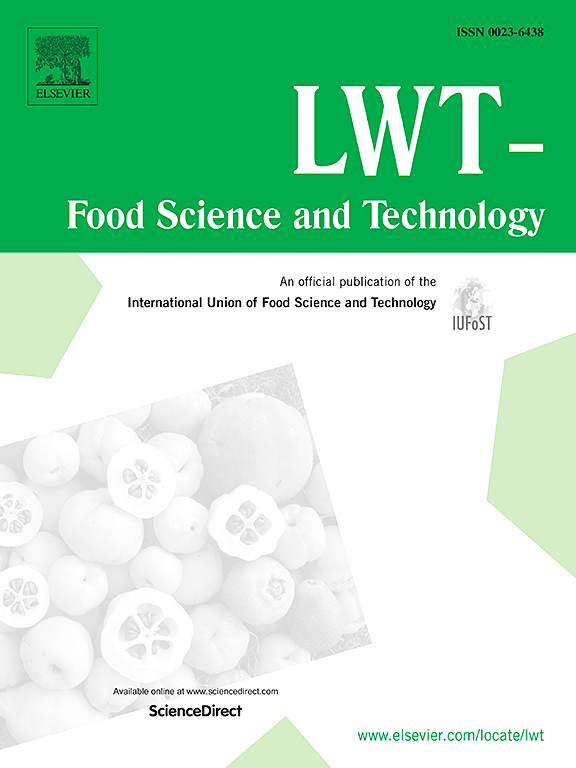将益生菌乳酸杆菌菌株作为保护性辅助培养物,防止硬质奶酪中真菌生长和毒素产生
IF 6
1区 农林科学
Q1 FOOD SCIENCE & TECHNOLOGY
引用次数: 0
摘要
Ras 奶酪是一种硬质奶酪,在埃及和其他地区得到广泛认可并具有相当重要的地位。这种奶酪经常处于高湿度的储存条件下,会促进真菌和酵母菌的繁殖,从而影响其质量。本研究旨在检验各种乳酸杆菌菌株作为保护性辅助培养物对真菌生长的能力,并确定在拉斯奶酪中发现的分离真菌的霉菌毒素产量和酶活性。实验设计包括几个处理:对照组使用保加利亚乳杆菌和嗜热链球菌;T1、T2 和 T3 处理分别为对照组+嗜酸乳杆菌、螺旋乳杆菌和酪酸乳杆菌。在 Czapek 葡萄糖琼脂培养基上,对照组在新鲜状态下的真菌数量最高(525 ± 46 CFU/g),而 T3 的真菌数量最低(277 ± 60 CFU/g)。添加了嗜酸乳杆菌(344 ± 53 CFU/g)和干酪乳杆菌(323 ± 73 CFU/g)的 T2 显示出最低的真菌总计数(302 ± 79 CFU/g),并且在 90 天成熟期,在储存奶酪中的抗真菌活性高于嗜酸乳杆菌(344 ± 53 CFU/g)和干酪乳杆菌(323 ± 73 CFU/g)。在 PDA 培养基上,T1 在新鲜样品中的计数最高(363 ± 66 CFU/g),而 T3 在 90 天后的计数最低(243 ± 59 CFU/g)。此外,黄曲霉和黑曲霉是 90 天后对照组中最主要的真菌,而在益生菌处理过的奶酪中,这两种真菌的出现率有所下降。拉丝奶酪中没有霉菌毒素,但分离出的黄曲霉能产生黄曲霉毒素 B1 和 G1,而分离出的黑曲霉能产生赭曲霉毒素 A。在拉丝奶酪中引入益生菌可能是一种重要的环保方法,可减轻真菌的存在,减少有损硬奶酪质量和安全的不良酶的产生。本文章由计算机程序翻译,如有差异,请以英文原文为准。

Probiotic Lactobacillus strains as protective adjunct cultures against fungal growth and toxin production in Hard cheese
Ras cheese, a type of hard cheese, is widely recognized and holds considerable importance in Egypt and various other regions. This cheese is often subjected to high-humidity storage conditions, fostering the proliferation of fungi and yeasts that can impact its quality. This study aims to examine the ability of various Lactobacillus strains as protective adjunct cultures against fungal growth, and to determine the mycotoxin production and enzymatic activities of isolated fungi found in Ras cheese. The experimental design comprised several treatments: Control was made using Lactobacillus bulgaricus and Streptococcus thermophilus; T1, T2 and T3 involved control + Lactobacillus acidophilus, Lactobacillus helveticus and Lacticaseibacillus casei, respectively. On Czapek dextrose agar medium, control exhibited the highest fungal count at fresh status (525 ± 46 CFU/g), whereas T3 displayed the lowest value (277 ± 60 CFU/g). T2 with Lb. helveticus showed the lowest total fungal count (302 ± 79 CFU/g) and had higher antifungal activity in stored cheese than Lb. acidophilus (344 ± 53 CFU/g) and Lb. casei (323 ± 73 CFU/g) at 90-day ripening. T1 yielded the highest count in fresh samples (363 ± 66 CFU/g), while T3 presented the lowest count after 90-days (243 ± 59 CFU/g) on PDA medium. Moreover, Aspergillus flavus and Aspergillus niger were the predominant fungi in control after 90-days, with reduced occurrences in probiotic-treated cheeses. The absence of mycotoxins was verified in Ras cheese; however, isolates of A. flavus showed the ability to generate aflatoxin B1 and G1, whereas isolates of A. niger could produce ochratoxin A. Both A. flavus and A. niger isolates exhibited the potential to produce lipases and proteases. The introduction of probiotics into Ras cheese may serve as an essential environmentally friendly approach to mitigate fungal presence and diminish the production of undesirable enzymes that compromise the quality and safety of hard cheeses.
求助全文
通过发布文献求助,成功后即可免费获取论文全文。
去求助
来源期刊

LWT - Food Science and Technology
工程技术-食品科技
CiteScore
11.80
自引率
6.70%
发文量
1724
审稿时长
65 days
期刊介绍:
LWT - Food Science and Technology is an international journal that publishes innovative papers in the fields of food chemistry, biochemistry, microbiology, technology and nutrition. The work described should be innovative either in the approach or in the methods used. The significance of the results either for the science community or for the food industry must also be specified. Contributions written in English are welcomed in the form of review articles, short reviews, research papers, and research notes. Papers featuring animal trials and cell cultures are outside the scope of the journal and will not be considered for publication.
 求助内容:
求助内容: 应助结果提醒方式:
应助结果提醒方式:


